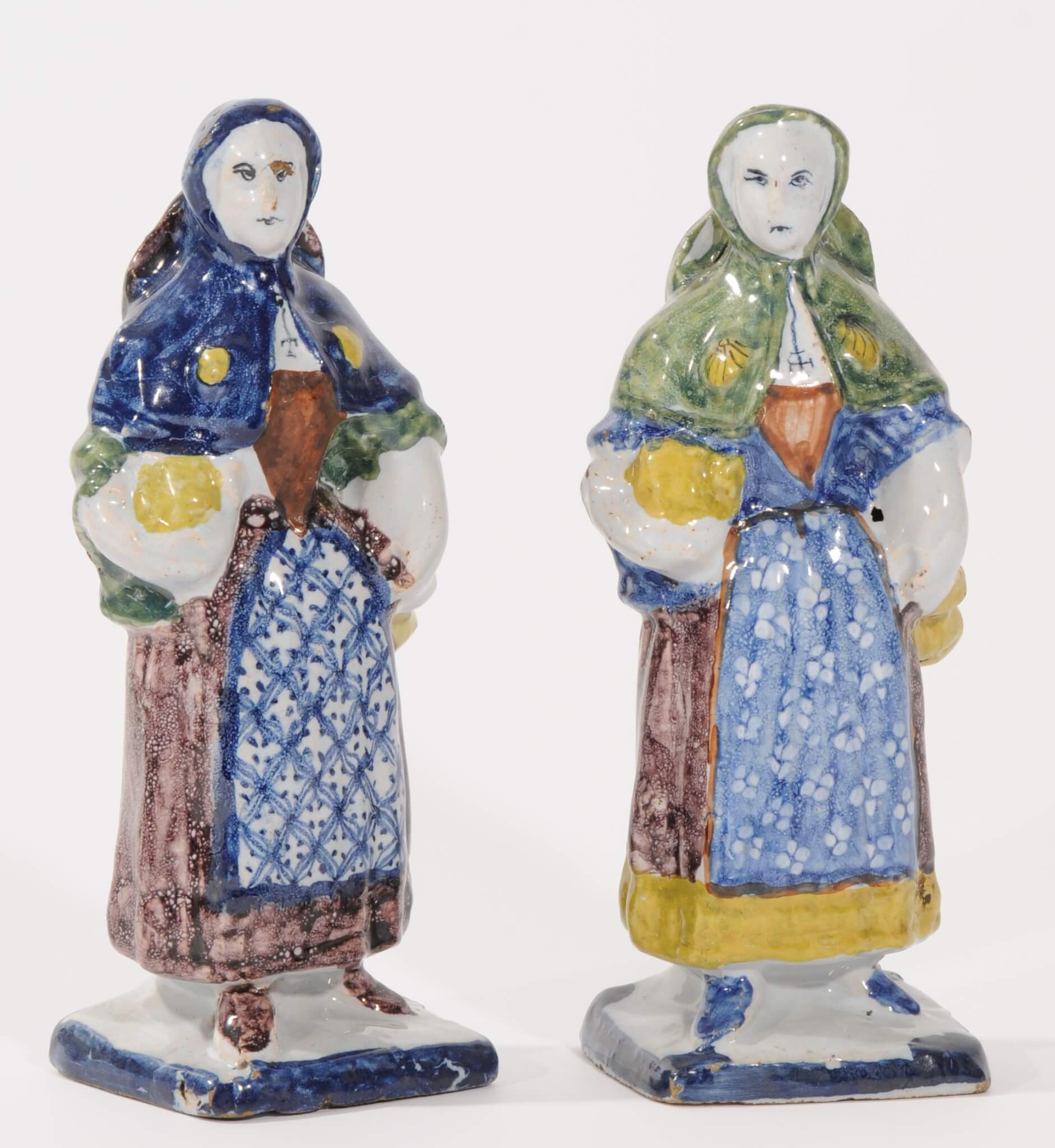
[popup_trigger id=”13756″ tag=”span”]![]() [/popup_trigger]
[/popup_trigger]
Images on this website are licensed under a
Creative Commons Attribution-NoDerivs 3.0 Unported License.
OBJECT
D1079. Two Polychrome Figures of Pilgrims
Delft, circa 1760
Each modeled as a lady with a manganese broadbrimmed hat suspended behind her neck, and wearing the yellow-shell-decorated green or blue pilgrim’s capelet of St. James, slightly open at the front to reveal a cross around her neck above an iron-red stomacher and blue or green jacket, a blue flowered or trellis-diapered apron over a manganese skirt and blue or manganese shoes, modeled supporting a yellow satchel under her right arm and a ‘pilgrim bottle’ in her left hand, and walking on a blue-edged flat square base.
Dimensions
Height: 17.7 and 17.8 cm. (6 15/16 and 7 in.)
Provenance
The Stigter-Gysberti Hodenpyl Collection, Singapore, 1989 through 2009; The Collection of the late mr. Maurits Aronson, Amsterdam, 1969 through (his death in) 1989
Note
The scallop shells on the capelet are an emblem of St. James, one of the Twelve Apostles. From the Middle Ages, the route to his shrine in the cathedral of Santiago de Compostela in Spain, known as ‘St. James’s Way’, was the most important Christian pilgrimage. The shell is known as coquille St. Jacques in French or Jacobsschelp in Dutch after the Latin name of Iacobus for St. James. Other pilgrim attributes of these figures include the cross pendant, the capelet, the broad-brimmed hat and the flask of a specific gourd-shape that has become known in metal, ceramics and glass as a ‘pilgrim bottle.’ Pilgrims also may walk with a staff.
Three different models of pilgrims are known to have been produced in Delft. Besides the current figure, the models include another lady without the capelet, but wearing a cross and a hat, her arms akimbo on her hips; and a male pilgrim carrying a child on his back.
Pilgrims might seem an unusual subject for a largely Protestant nation, but the theme and the figures it inspired have less to do with religion than with an allegory of love. The subject was popularized through a 1708 engraving of ‘Les Pèlerins de l’Isle de Cythère’ by Bernard Picart (1673-1733), in which Cupid leads a pilgrim couple to a boat for the voyage to Cythera, the Greek island associated in antiquity with Venus, the goddess of love. The subject appeared again in the slightly incendiary 1717 painting of ‘Le Pèlerinage à Cythère’ by Jean-Antoine Watteau (1684-1721), who, in turn, may have been inspired by the contemporary opera, ‘Les Trois Cousines’ by Florent Carton Dancourt (1681-1725). But it was the Picart print or an engraving after it by Claude Duflos (1665-1727) that provided the graphic source for representations of the subject both on Chinese Export porcelain wares of circa 1745-50, and in Meissen porcelain as a pair of figures of pilgrims modeled by Johann Joachim Kändler, circa 1744, examples of which, in the Pauls-Eisenbeiss Collection, Basel, are illustrated in I. Menzhausen, J. Karpinski, In Porzellan verzaubert, Basel 1993, p.143. The popularity of the subject persisted throughout Europe for at least another decade, and at Meissen, a second pair of pilgrims was modeled by Peter Reinicke, circa 1755, illustrated in Y. Adams, Meissen Figures 1730-1775: the Kaendler Period, Atglen (PA) 2001, p. 148, nos. 401-403. Further examples were produced contemporarily both in Continental and English porcelain, and possibly served, if not as direct models, at least as the inspiration for the Delft figures.








